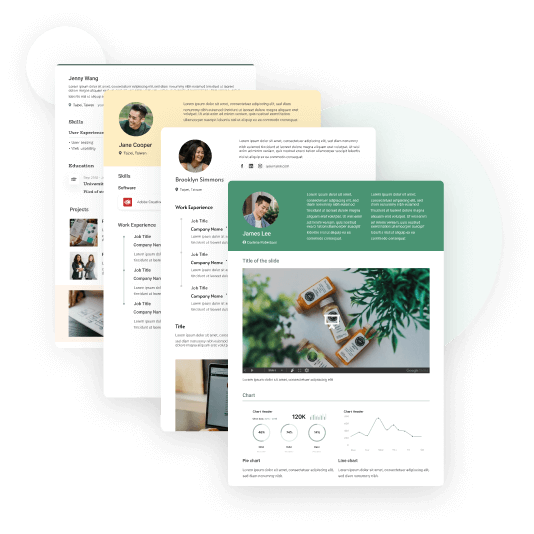5 Essential Steps to Build A Convincing Resume | Resume Building Guideline
In today's competitive job market, a well-written resume is essential. Follow these 5 essential steps to learn how to create a compelling resume that will catch the attention of potential employers. Use this guide to ensure that you are preparing all the necessary components when writing a resume for a job application.
📌 TABLE OF CONTENTS :
What Is a Resume?
A resume summarizes an applicant's background, relevant experience, and qualifications. It usually comes in handy during the process of job application and college application (bachelor, master & Ph.D. degrees).
A good resume clearly presents the value and profession of a candidate on a limited length. Almost every company requires resumes from job seekers during recruitment, which is the major selection criteria for the candidate's next job search step - Interview.
As time passed, resumes have evolved from a few pieces of paper to online documents, web pages, and even multimedia formats like videos. Since it's one of the most important documents used during the job/college application process, everyone should learn how to prepare one, as well as keep a professional resume updated.
📚 Further reading: What is a Resume? [Definition, Element, Writing Tips, and Examples]
Why Is a resume Important in a Job Application?
According to Glassdoor's statistics, each job opening attracts an average of 250 applications from job seekers. Among these applicants, around 4 to 6 (nearly 2%) will go through the interview process, and only ONE will receive the job offer.
Another crucial fact, it takes no more than 6 seconds for a hiring manager/recruiter to review a resume. Under intense competition, how to catch a hiring manager’s attention in a split-second becomes a vital issue for job seekers.
A well-designed and professionally-tailored resume is the key in all job application. Keep in mind that an eye-catching resume doesn’t necessarily involve fancy format or word usage, wisely-composed content and legible structure is the core.
What Is the Difference Between a Resume and a CV?
A CV is short for "Curriculum Vitae," which is Latin for "course of life." It is a detailed record of a person's professional experience, including work history, publications, certifications, awards, and other career achievements.
There are 4 main differences between a Resume and a CV:
1. Content
- A CV includes more detailed information about an applicant’s professional life.
- A resume puts more emphasis on relevant information to a specific job position.
2. Purpose
- A CV is mostly required during application process in academia, medicine or science fields.
- A resume is mostly required during general job application process.
3. Length
- A CV’s length is mostly over two page, and it would get extended overtime along with the growth of experience.
- A resume’s length is mostly within two pages, and the content would be tailored and updated in accordance to job search status.
4. Design
- A CV usually has a simple and plain layout, and not many varieties in terms of format.
- A resume has a variety of choices for layouts based on different industries, and a general format.
Regardless of the comparison above, it was noticed that the word usage of "resume" is generally preferred in some countries, while "CV" is in others. For instance, in the U.S., Canada, India, and Australia, "resume" is more commonly used, while in most European, South American, and African countries, "CV" is more prevalent.
📙 Further reading: What Is A CV: CV Meaning, Writing Tips + CV Template
Offline Resume Vs. Online Resume: What Are They and When to Use
Offline Resume
The most traditional and original type of resume is printed out as 1 - 2 pages of paper. It comes in handy during offline job interviews (or walk-in interviews) and school admission interviews.
We recommend you convert your resume to PDF files before printing it to avoid inconsistencies.
Online Resume
1. PDF/Word Resume :
One of the most common resumes is in PDF or Word formats. PDF & Word resumes can be attached to emails while applicants send out applications or other online channels like WhatsApp, Messenger, LinkedIn, etc. It can also be printed out as a paper-type resume.
If there's no specific requirement for the file format, always send your resume in PDF to avoid inconsistencies. Documents in .doc format sometimes show inconsistencies on different devices, for instance, disarranged layout, incorrect font, or even worse, mojibake (garbled text). Another reason for sending your resume in PDF the device compatibility. Not every Mac installed the program to run Microsoft Word, it might cause an awkward situation when a hiring manager can't open your resume file.
2. Website Resume :
It is getting more and more popular to build a personal website/web-page, especially for professions required to maintain portfolios and side projects, like software engineers and designers.
Nowadays, website builder software has made it easier and more affordable to create a website. You can easily build a single web page to showcase your portfolio and personal achievements, which is a great way to establish your personal brand and display your creativity.
3. Video Resume :
Typically, a video resume is not necessary when applying for a job. However, it may be requested for internships or extracurricular activities. Jobs like teacher sometimes require you to make a video to demonstrate your teaching skills. Jobs that involve video editing or interpersonal skill, such as video editors, entertainers, and live streamers, also often need a video resume.
5 Steps to a Compelling Resume Writing
If you're planning to create a new resume or update an old one, there are 5 helpful steps you can follow. These steps can also provide students and freshers with an opportunity to reflect on their future career path.
Step 1 : Ask yourself questions to figure out your goal and career aspiration.
👉 For students/freshers
- What do I want to do? Do I have any relevant experience?
- What personality do I have? What career suits my personality traits?
- What skills do I have? How can these skills be utilized in the workplace?
- What are the jobs I can get with my college major? Do I want a career related to it?
- What have I achieved during college? Does my extracurricular or internship experiences highlight my core advantage?
👉 For general job seekers (career change)
- Am I satisfied with my current career path?
- What do I have to offer in the new position?
- What is my biggest accomplishment in my current role?
- Am I looking for opportunities to advance within the same career or industry?
- What have been some of the biggest challenges I faced in my job(s)? How did I resolve them?
Step 2 : Perform research on companies and occupations that you are interested in.
Researching the companies you're applying for can help you understand more about the working culture, their latest events, etc. These topics will become handy when you talk to your future employers.
- Online research: To gather information about a company, visit its website, Facebook fan page, LinkedIn page, and forums. These sources will detail the company's corporate culture, vision, and current campaigns. This information can help you tailor your resume to fit the company's needs and excel in your interview.
- Offline research: Attending company events in person can give you valuable information and help you make a good impression on potential employers, giving you an advantage in the recruitment process. Additionally, you can gather reliable information from friends, classmates, and colleagues by simply asking around.
In addition to finding information about the company, you can search for your desired occupation to get a better understanding of the job, what skills it requires, how you can become a fit for the job, etc. Let's look at some other reasons of researching the occupatin of interests beforehand.
- Job responsibility research: For freshers, you can better understand the duties and responsibilities for a certain job role and to analyze further if it is suitable for you. For general job seekers, researching a job's responsibility can give you a clearer idea of what skills can be leveraged on your resume and what skills you lack.
- Keyword research: During the modern hiring process, chances are that a resume has been categorized as "Unqualified" even before it is read by a human (recruiter, hiring manager, employer, etc.). On average, a job position would attract 250 resumes, let alone how immense the number of resumes received by a prestigious enterprise everyone dreams of working for is.
- ATS (Applicant Tracking System) is a software adopted by 90% of big companies to assist recruiters in arranging, scanning, and ranking resumes (or job applications) during the hiring process. Keywords on Resumes play an important role during the scanning procedure, so wisely including keywords in resumes should be necessary.
Step 3 : List down all past experiences, accomplishments and skills.
It is highly suggested to make a habit of keeping track of personal experiences & accomplishments that can be potentially utilized on resumes. By noting down these information in one place, it can be easily turned into a CV or made use of as resume writing materials.
It is highly suggested to keep track of personal experiences & accomplishments that can be potentially utilized on resumes. By noting down this information in one place, it can be easily turned into a CV or used as resume writing materials. If you are starting fresh on preparing a resume, begin with experiences that happened within five years (If you are a fresh college graduate, it is not recommended to include high school experiences.). You can follow the list below.
For freshers:
- Internship experiences & achievements
- Extra-curricular experiences & achievements
e.g. volunteer work, international competition, student club, and etc. - Academic experiences & accomplishments
e.g. teaching assistant, academic program, academic publication, academic conference, and etc. - Awards/Honors
e.g. academic award, extra-curricular award, service award, and etc. - Certificates
e.g. language certificate, skill certificate, online/offline program certificate, and etc.
For all job seekers
- Work history & accomplishments
- Projects & career portfolios
- Awards/Honors
- Certificates
Step 4 : Choose/Make a resume format
There are 3 main types of resume formats, which are chronological resume, functional resume, and hybrid (combination) resume. Each resume format can be utilized under different circumstances. The strength and weakness of each resume format will be further elaborate in this article about the best resume formats.
Step 5 : Select suitable information to put on the resume
Cross match job responsibility research (Step 2) and your past experiences/accomplishments/skills list (Step 3) to locate the intersection. Select 3 to 5 core skills that can make you the right fit for the position and stand out from other candidates. Use your experiences and accomplishments to support your statements and build a professional image. Remember to choose the most relevant and eye-catching information to include.
CakeResume is the best free online resume builder available on the market. With our intuitive interface, you can freely drag-drop and edit any resume section. We support making online resume and website resume as well as portfolio. Create an eye-catching resume in less than 10 minutes and start your job search journey today!
More Career and Recruitment Resources

A culture & language lover. Currently working at CakeResume as Content Marketing Strategist. Passionate about developing digital marketing strategies based on data. ➡ View My CakeResume






